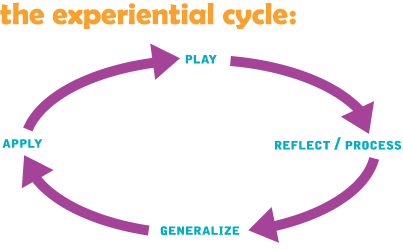|
|

Adventure
Adventure is not something that you do; it is a way of doing. Any classroom, living room, office or community space can be adventurous when it challenges and allows learners to balance on the edge of success and failure. Adventure comes when learners are provided opportunities to grow and stretch and take real risks, intellectually, emotionally, and socially. We can have adventure anywhere people are allowed to be themselves, speak their truth and know that they will be safe doing it. Adventure does not come through activities but is a result of the process, whether you are leading a rock climbing trip, a team challenge, marketing campaign, art project or a science experiment.
Brief History of Adventure
Experiential education was first utilized in the early days of World War II when there was a pressing need for survival training. Kurt Hahn founded Outward Bound in 1941 to give England’s younger generation survival skills training. He developed individual and group activities in small boats that worked on strengthening a young sailor’s courage, commitment and collaborative skills. Thirty years later Outward Bound came to the United States and spread wilderness programs focused on building self-esteem in troubled youth. A spin-off of Outward Bound, Project Adventure, was formed in 1971. It is a non-profit, like Empowering, Inc., and was created to offer adventure experiences in many schools, colleges and universities. Empowering, Inc, was formed as a non-profit in 1999, serving the community with portable, custom designed adventure programs and training opportunities.
Experiential Education
Experiential learning is an approach to education that has grown in popularity over the past twenty years. This type of learning occurs when learners participate in some activity, reflect upon the activity, use their analytical skills to derive some useful insight from the experience, and then incorporate their new understanding(s) into their daily lives. What experiential learning does best is capture the interest and involvement of the participants, but most importantly it contributes significantly to the transfer of learning.
Experiential education refers to a Purposeful Action, a Reflection, and an Application.

Experience/ Play- What is purposeful action? It means that, just like in an academic setting, we set up games and play with objectives in mind. We don’t just play, we play with a purpose.
Reflection/ Process – Debrief the activity that just took place by asking questions of the group. Allow each member to speak without interruption. What did we just do? What did we learn? In a perfect world, what would have made it better? Did we meet goals? What was that like for you? Set new goals.
Generalize- Where might I use this activity, lesson or tool again? How might it benefit others?
Apply – Practice the new skill in a new situation; lead the experience or activity again.

How do I choose activities?
Chose activities that offer opportunities to practice the skills you hope to teach. Sequence the flow of the activities you choose in a way that takes the time, space, ability and age of group members’ limitations into account. Choose activities to support indoor or outdoor learning depending on the weather and space.
Sequence of events
Goal Setting allows learners to differentiate between individual and group goals.
Warm ups, name games, get to know games and ice breakers are used to set the tone and establish a safe setting for working together.
Problem solving activities require the group to struggle through some aspect of the experience in order to solve the problem, thus reaching the goal, as a group. Issues of power and control surface. Processing becomes important.
Trust building activities support learners to begin to increase emotional and physical trust within group or family. Learners feel included and can encourage each other; they can deal with trust issues. Is it OK to make a mistake?
Transition activities help move the group from one event to another, support kids’ success in grocery store lines, lessen the boredom on a long road trip, etc….
Timing
| • |
Start using play as soon as you can, continue use of activities regularly. |
| • |
Play games as soon as possible, first thing in the morning, as a transition between activities, to end the day on a positive note. |
| • |
Play consistently as a normal part of the routine and a special time for laughter and guided social interactions. |
Space
Wherever you can make it and keep it safe.
|
|
|
|



